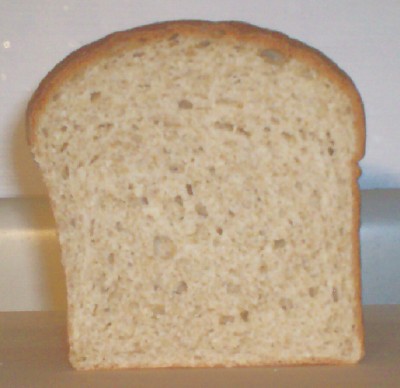
The preferment for this loaf contained 100% of the water and yeast, as well as 1/4 of the total salt. The malt extracts contained in the malted milk powder supplied the necessary diastatic action to sustain the yeast during the long preferment stage. Here is the formula:
Poolish:
70% Whole Wheat Flour
70% Water
5% Malted Milk Powder
2% Vital Wheat Gluten
0.6% Instant Dry Yeast
0.5% Salt
0.18% Soy Lecithin Granules
The photo below shows the sponge after 8 hours of fermentation.

Dough:
30% Bread Flour
2.8% Shortening
3.5% Sugar
1.5% Salt
The poolish was fermented for 8 hours at 75°F (24°C). This should be long enough for the enzyme phytase to hydrolyze most of the phytic acid content of the whole wheat flour into inositol and orthophosphoric acid. Even after 8 hours, the poolish had not yet reached the “drop”, so the fermentation time might be extended. There was a 1.8% fermentation loss during the sponge stage.
The ripened poolish was re-mixed with the dough ingredients using a KitchenAid K5SS stand mixer equipped with a spiral dough hook. Total mixing time was 5½ minutes, with the first two minutes at low speed and the remainder at speed setting #2. After a short rest of about 10 minutes, the dough was panned. Proofing and baking proceeded normally.

Lovely panned whole wheat bread, Bob.
Interesting, i've never heard of malted milk powder. Why have you chosen shortening over, say, butter?
Happy baking,
Khalid
Malted milk powder has been around a long time in the US, but it does not seem to have had much international distribution. It is mostly added to fresh milk or a mixture of milk and ice cream (a "malted milk shake") to impart a pronounced malty flavor. When used in bread baking, it supplies malt enzyme extracts and powdered whole milk.
Butter does have shortening power, but it is used in baking mostly for flavor. Shortening, on the other hand, is bland, but promotes a softer crumb and better keeping qualities. The small amount of lecithin in the formula increases the effectiveness of shortening.
Bob
but I used malted milk powder and diastatic malt flour (didn't have any lecithin so I added the diastatic malt). What brand of malted milk powder do you use?
I use Carnation (Nestle) malted milk powder. The first ingredients listed on the package are wheat and barley malt extracts, followed by powdered milk. There is no sugar added, but lactose is present in the milk. The first ingredient listed in Ovaltine is sugar, so I avoid it.
http://www.soupbase.com/Carnation-Malt-Mix-Original/productinfo/CMMO/
The function of lecithin is to act as an emulsifier. It imparts a much drier feel to the dough as it is being handled, along with other benefits such as a more uniform crumb and better loaf loaf symmetry.
Our local WalMart carries the Carnation (Nestle) malted milk powder. For anyone that want to try this, don't buy the chocolate flavor. I have to get some lecithin.
getting pretty close to WW Wonder Bread which is a real compliment. Well done and
Happy Baking
I've just made my third loaf from this recipe. It's now my go to recipe for light wheat bread.
nice looking loafs, Bob. I am glad to have come across your post. I am always on the look out for formulas for sandwich bread. Hubby and customers want that.
Could I use liquid Lecitin instead of granules? Why do you use the Wheat Gluten? Shortening....I have an aversion against it but I see as a healthy substitute I can use butter.
Barbara
Liquid lecithin should be an acceptable alternative to granular lecithin. Vital wheat gluten and shortening both serve to boost volume. I use Spectrum® brand organic shortening, which has a lower percentage of saturated fat than butter.
Bob
After baking bread for over two years using standard mix of ,yeast ,flour,salt ,and water,with mixed results :ie: to heavy or to light or when using sandwich loaf tins with lids the loafs were to crumly and tore easily when cutting ,have now tried making the loafs using powdered milk mixed with water,with great success, a bit crusty on the out side but nice and soft inside, but it does have that powdered milk flavour which could be a turn off for some, but the advantages of this appears to be, its a more tolerant of mistakes . cuts without tearing and has not crubled as yet . My question is ,will the bread steam cook rather than bake when using tins with lids :ie: s/wich loaf tins .
Unless you are using baker's special dry milk (which is processed at high temperature), dry milk and products containing dry milk will significantly soften the dough. This is actually of benefit with bread that contains a high proportion of whole wheat dough, which tends to be somewhat stiff.
I do not use a lidded bread pan (such as a "pain de mie" or "Pullman" pan), so I am sure how to respond to your question about baking. Just give it a try and judge the results for yourself.
Bob
I just started playing with WW sandwich bread. How much difference in flavor, in your opinion, does the poolish make? It would seem the malted milk powder and sugar would already impart a lot of flavor to the bread.
Malted milk powder does add flavor to bread, but fermentation is (in my opinion) is necessary to develop the full flavor of a loaf. Also, milk acts as a pH buffer, which allows fermentation to continue longer. This results in a mellower whole wheat dough. Subjecting the whole wheat potion of the formula to long fermentation allows phytic acid to be broken down, which is generally regarded as nutritionally beneficial.
Thanks for the reply, Bob S. I'll work on this!